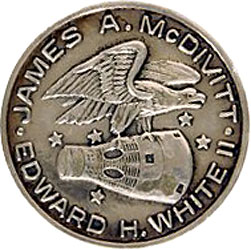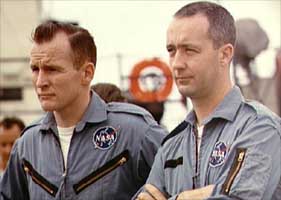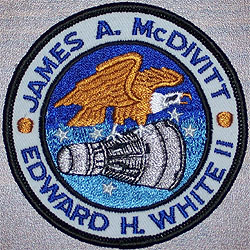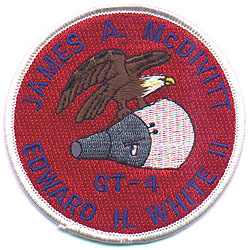

Crew & Mission
 The crews for the Gemini-IV mission were selected on July 27, 1964. Prime crew would be: James A. McDivitt and Edward H. White, and the back-up crew would be: Frank Borman and James Lovell.
The crews for the Gemini-IV mission were selected on July 27, 1964. Prime crew would be: James A. McDivitt and Edward H. White, and the back-up crew would be: Frank Borman and James Lovell.
The Gemini-IV mission was a four day flight. Lauch was on June 3, 1965. This flight was the first of three successive long duration missions during the Gemini programm. The crew McDivitt and White were the first American astronauts to open a spacecraft hatch and have a member participate in extravehicular activity. The hatch was open for 36 minutes and White was outside the spacecraft for 20 minutes of that time.
During its flight Gemini-IV attained a maximum apogee of 159.0 miles and a low perigee of 86.1 miles. The landing came on June 7, 1965, in the western Atlantic after 97 hours, 56 minutes, and 12 seconds of spaceflight. The landing time was 12:12:12 pm EST. The impact point was approximately 50 miles up-range from the prime recovery ship, the USS Wasp. The crew recovery was effected at 1:09 pm ans the spacecraft was recovered at 2:28 pm.
A Personal Story
..."The name we selected for the vehicle was American Eagle. Unfortunately, we were unable to use this, and we were known as Gemini IV.
Ed and I used the American flag on our shoulders as our patch. This was the first time the American flag had been worn on a pressure suit and it has continued to be used there ever since. The original flags we had sewn on we purchased ourselves. Later on of course, NASA made this an integral part of the pressure suit"...
Astronaut, Jim McDivitt in: "All we did was fly to the moon"
..."NASA officials directed that in the future the astronauts would not assign names to their spacecraft and would use only numbers to identify each mission. Because the brass still had the power to knock a man out of a flight, the crews wisely kept their comments to themselves and, on the surface at least, complied with the new rules.
James McDivitt and Edward White judged the entire affair as evidence there were some screws loose in Washington, but kept their counsel to themselves. They already had named their Gemini-4 American Eagle, which seemed appropriate and patriotic. But orders were orders, and the second manned Gemini mission went into space with the simple, sterile name of Gemini-4"...
From: Moonshot, the inside story of America's race to the moon. By; Alan Shepard and Deke Slayton.
..."Jim McDivitt had wanted to name his Gemini American Eagle, but NASA HQ wasn't having any more names. Jim and Ed decided to put the American flag on their pressure suits, wich we then did for years"...
From: DEKE!, U.S. manned space: from mercury to the space shuttle, by; Donald K. Slayton.
Artwork
Like previous missions, the crew carried a load of gold and sterling silver medallions with them. These medallions showed their names, a Gemini capsule and an American Eagle. Since no patches were yet flown, this design can be considered as "the next best thing". Unlike the Gemini-3 coin, which was later made into a patch and worn by one of its crewmembers - indicating that the astronauts considered the designes on the coins as "official" logo's - the Gemini-4 logo was not further exploited by the astronauts.
Collecting Gemini-4


(Left) Gemini-4 patch from the Michigan's Own, Inc., Military & Space Museum. Photo taken by:Scott Furtaw.
(Right) A commemorative patch was made in the early 2000's by Randy Hunt. Probably, he guessed the colors.